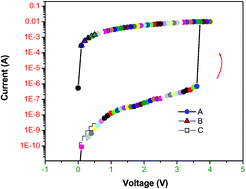Dopant-configurable polymeric materials for electrically switchable devices
Abstract
We demonstrate that the conductivity of conjugated poly[2-methoxy-5-(2′-ethylhexyloxy)-p-phenylene vinylene] (MEH-PPV) can be configured by changing the dopant concentrations in the polymer electrochemically when an external electric field is applied. Two types of switchable devices were fabricated based on the dopant configurable polymer: (1) devices were composed of a layer of MEH-PPV and a layer of solid inorganic electrolyte (RbAg4I5) sandwiched between two metal electrodes; (2) devices were only composed of a MEH-PPV layer sandwiched between two metal electrodes, but the MEH-PPV layer was doped electrochemically with various anions such as hexafluorophosphate (PF6−) and trifluoromethanesulfonate (CF3SO3−). When a voltage above a threshold value is applied between the two metal electrodes, depending on polarity, the conductance of the devices can be electrically switched between its low-conductance “off” state and its high-conductance “on” state, and the devices can be switched on and off reversibly and repeatedly.


 Please wait while we load your content...
Please wait while we load your content...